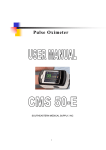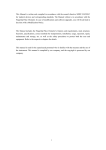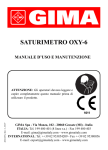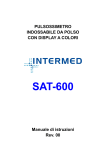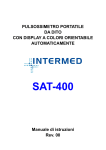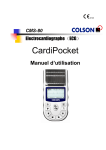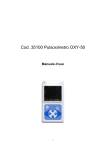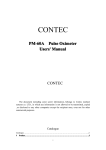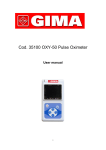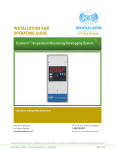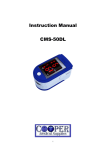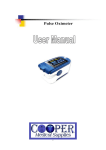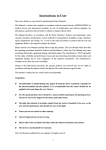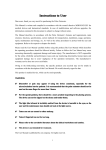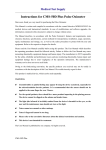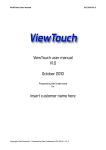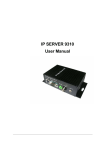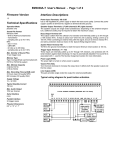Download CMS-50E Pulse Oximeter
Transcript
CMS-50E Pulse Oximeter CONTEC MEDICAL SYSTEMS CO., LTD I This Manual is written and complied in accordance with the council directive MDD 93/42/EEC for medical devices and corresponding standards. The Manual written is in accordance the Fingertip Pulse Oximeter. In case of modifications and software upgrades, you will be advised in due time with a Modification Notice. The Manual includes the Fingertip Pulse Oximeter’s features and requirements, main structure, functions, specifications, correct methods for transportation, installation, usage, operation, repair, maintenance and storage, etc. as well as the safety procedures to protect both the user and equipment. Refer to the respective chapters for details. This manual is used for the experienced personnel who is familiar with the measure and the use of the instrument. This manual is compiled by our company, and the copyright is possessed by our company. Instructions to User Dear Users, thank you very much for purchasing Fingertip Pulse Oximeter. Please read the following two pages very carefully before using this equipment. Please read these instructions carefully before using this equipment. These instructions describing the operating procedures should be followed strictly. Failure to follow these instructions can cause measuring abnormality, equipment damage and personal injury. The manufacturer is NOT responsible for the safety, reliability and performance issues and any monitoring abnormality, personal injury and equipment damage due to user’s negligence of the operation instructions. The manufacturer’s warranty service does not cover such faults. This product is medical device, and can be used repeatedly. Its using life is 3 years. WARNING: 0 For the special patients, there should be a more prudent inspecting in the placing process. The device can not be clipped on the edema and tender tissue. 0 The light (the infrared is invisible) emitted from the device is harmful to the eyes, so the user and the maintenance man should not stare at the light. 0 Testee can not use enamel or other makeup. 0 Testee’s fingernail can not be too long. 0 Please refer to the correlative literature about the clinical restrictions and caution. II 0 This device is not intended for treatment. Table of Contents 1. SAFETY .............................................................................................................................................1 1.1. INSTRUCTIONS FOR SAFE OPERATIONS ................................................................................... 1 1.2. WARNINGS ............................................................................................................................. 1 1.3. ATTENTIONS ........................................................................................................................... 1 2. OVERVIEW ......................................................................................................................................1 2.1. FEATURES .............................................................................................................................. 2 2.2. ANTICIPATIVE APPLICATION ................................................................................................... 2 2.3. ENVIRONMENT REQUIREMENTS ............................................................................................. 2 3. PRINCIPLE AND CAUTION...........................................................................................................2 3.1. PRINCIPLE OF MEASUREMENT ................................................................................................ 2 3.2. THE ATTENTION OF OPERATION ............................................................................................. 3 3.3. CLINICAL RESTRICTIONS ........................................................................................................ 4 4. TECHNICAL SPECIFICATIONS ...................................................................................................4 5. ACCESSORIES ................................................................................................................................5 6. INSTALLATION ..............................................................................................................................5 6.1. VIEW OF THE FRONT PANEL .................................................................................................... 5 6.2. MOUNTING OF THE LANYARD CORD................................................................................. 5 7. OPERATING GUIDE ......................................................................................................................6 8. CLEANING AND DISINFECTING .................................................................................................9 9. REPAIRING AND MAINTENANCE.............................................................................................10 10. TROUBLESHOOTING.................................................................................................................10 11. KEY OF SYMBOLS.......................................................................................................................11 12. FUNCTION SPECIFICATION ....................................................................................................11 III 1. Safety 1.1 Instructions for safe operations ◇ Check the main unit and all accessories periodically to make sure that there is no visible damage that may affect patient’s safety and monitoring performance. It is recommended that the device should be inspected once a week at least. Please stop using the monitor when there is obvious damage. ◇ Necessary maintenance must be performed by qualified service engineers ONLY. Users are not permitted to maintain it by themselves. ◇ The oximeter cannot be used together with devices not specified in User’s Manual. Please use the devices recommend by Manufacturer. 1.2 Warnings 0 Explosive hazard—DO NOT use the oximeter in environment with inflammable gas such as some ignitable anesthetic agents. 0 DO NOT use the oximeter while the testee is under measurement of MRI and CT. 0 Be cautious of the lanyard cord, please do not break the lanyard cord during usage to avoid device damage. Please don’t use lanyard cord if allergic to lanyard cord. 0 Please don’t use this product if allergic to rubber cushion. 0 Please dispose the device, accessory and packing (including plastic bag, foam and carton) according to local law. 1.3 Attentions Keep the oximeter away from dust, vibration, corrosive substances, explosive materials, high temperature and moisture. If the oximeter gets wet, please stop using. When it is carried from cold environment to warm and humid environment, please not use it immediately. DO NOT operate keys on front panel with sharp materials. High temperature or high pressure steam disinfection of the oximeter is not permitted. Refer to User’s Manual for instructions of cleaning and disinfection. Do not have the oximeter immerged in liquid. When it needs cleaning, please wipe its surface with disinfect solution by soft material. Do not spray any liquid on the device directly. When cleaning the device with water, the temperature should be less than 60℃. 2. Overview The pulse oxygen saturation is the percentage of HbO2 in the total Hb in the blood, so-called the O2 concentration in the blood. It is an important bio-parameter for the respiration. For the purpose of 1 measuring the SpO2 more easily and accurately, our company developed the Fingertip Pulse Oximeter. The device can measure the pulse rate simultaneously. The Fingertip Pulse Oximeter is tiny, and with low power consumption, convenient to use and carry. You just need to put the fingertip into the sensor of the device, the SpO2 value will appear on the screen immediately. In the clinical practice, the tolerance is smaller than ±2% in the range from 70% to 100%. 2.1. Features A. The device can accurately measure SpO2 and pulse rate. B. The device will power off automatically if no signal is detected within 5 seconds. C. Lithium batteries is required for operating, and the continuous working time is 12 hours. D. When Low-Voltage Warning is shown on screen, the device maybe not operate normally. E. Light and portable, total weight with batteries is about 50g. F. Classification: Class II a, (MDD93/42/EEC G. With the function of USB transmission and wireless transmit. H. It can store patient’s data and with alarm function. IX Rule 10) 2.2. Anticipative application The Fingertip Pulse Oximeter can detect SpO2 and pulse rate through patient’s finger, and indicate the pulse intensity by the bar-display. This device is applicable for use in home, hospitals (surgery, anesthesiology department, department of pediatrics, ordinary sickroom), oxygen bar, the community medical treatment, physical care in sports (you can use the device before or after the sport, but it is not recommended to use it during the sport) and so on. This device is not appropriate for the ceaseless monitoring of the patients. 2.3. Environment requirements Transport and storage a)Temperature: -20°C~55°C b)Humidity: ≤95% c)Pressure: 500hPa~1060hPa Operating a)Temperature: 10°C ~40°C b)Humidity: 35%~75% c)Pressure: 700hPa~1060hPa 3. Principle and Caution 3.1. Principle of measurement The measurement of pulse oximeter is that it uses a multi-functional oxyhemoglobinometer to 2 transmit some narrow spectrum light bands through blood samples, and to measure attenuation of spectrum with different wavelengths according to the characteristic that RHb, O2Hb, Met Hb and COHb absorb the light of different wavelength, thereby determining O2Hb saturation of different fractions. O2Hb saturation is called “fractional” O2Hb saturation. Fractional O2Hb saturation = [O2Hb / (RHb + O2Hb + Met Hb + COHb) x 100 Oppositely, pulse oxygen oximeter measures functional O2Hb saturation: Functional O2Hb saturation = [O2Hb / (RHb + O2Hb)] x 100 Present SpO2 oximeter transmits light of two wavelengths only, red light (wavelength 660 nm) and infrared (wavelength 940nm), to differentiate HbO2 from HbR. One side of the sensor contains two LEDs, and the other side contains a photoelectric detector. SpO2 oximeter measures HbO2 saturation in the blood by the light plethysmograph when the pulse beats. The result is quite precise when HbO2 saturation is over 70 % ~ 100%. Figure1. Operating Principle 3.2. The attention of Operation A. The equipment should be fully tested to see if it can be used normally before using. B. The finger should be placed properly (see the attached illustration of this manual), or else it may cause inaccurate measurement. C. The SpO2 sensor and photoelectric receiving tube should be arranged in a way with the testee’ s arteriole in a position in between. D. The SpO2 sensor should not be used at a location or limb tied with arterial canal or blood pressure cuff or receiving intravenous injection. E. Make sure the optical path is free from any optical obstacles like rubberized fabric, otherwise it may result in venous pulsation and inaccurate measure of SpO2. F. Excessive ambient light may affect the measuring result. It includes fluorescent lamp, dual ruby light, infrared heater, direct sunlight and etc. G. Strenuous action of the testee or extreme electrosurgical interference may also affect the accuracy. H. Please clean and disinfect the device after operating according to the user manual. 3 3.3. Clinical restrictions A. As the measure is taken on the basis of arteriole pulse, substantial pulsating blood flow of the testee is required. For a testee with weak pulse due to shock, low ambient/body temperature, major bleeding, or use of vascular contracting drug, the SpO2 waveform (PLETH) will decrease. In this case, the measurement will be more sensitive to interference. B. For those with a substantial amount of staining dilution drug (such as methylene blue, indigo green and acid indigo blue), or carbon monoxide hemoglobin (COHb), or methionine (Me+Hb) or thiosalicylic hemoglobin, and some with icterus problem, the SpO2 determination by this monitor may be inaccurate. C. The drugs like dopamine, procaine, prilocaine, lidocaine and butacaine may also be a major factor blamed for serious error of SpO2 measure. D. The SpO2 value serves only as a reference value for judgement of anemic anoxia and toxic anoxia, some patients with serious anemia may also report good SpO2 measurement. 4. Technical specifications A. Display mode: 65K Color OLED display SpO2 measuring range: 35%~100% Pulse rate measuring range: 30bpm~240bpm Pulse waveform display: bar graph display Battery indication: OLED Signal B. Power supply requirement: Lithium battery × 1 Adaptable range: 3.5V~4.2V C. Operating current: ≤80mA D. Resolution: SpO2 : 1% Pulse Rate : 1bpm E. Accuracy: SpO2 :70% to 100%±2 digits, below 70% unspecified Pulse rate:±2 bpm or ±2% (select larger) F. Measurement at low perfusion: The values of SpO2 and pulse rate can be displayed properly when pulse saturation is at 0.4%. Accuracy of SpO2:±4% Accuracy of Pulse rate:±2bpm or ±2% (select larger) G. Resistance to surrounding light: The difference between the value measured in the condition of man-made light and indoor natural 4 light and that of darkroom is less than ±1%. H. Automatic shutdown function: The device will power off automatically within 5 seconds when there is no finger in the device. I. The view direction (four direction) can be changed by pressing the power button when it works. J. One lithium battery continuous working time is 12 hours. K. It can store patient’s data for 24 hours. L. This product has the real-time transmission function, it can upload the measured value to pc with wire or wireless. 5. Accessories 1. A lanyard cord 2. A User Manual 3. A Charger (used for recharge the lithium battery) 4. An USB cable (used for recharge the battery in the computer and transfer the data to the pc) 5. A CD (drive for USB and software for the pc) 6. Installation 6.1. View of the front panel Figure2. front view 6.2. Mounting of the lanyard cord Step1. Put the end of the cord through the hole. 5 Step2. Put another end of the cord through the first one and then tighten it. 7. Operating Guide 7.1 Let the patient’s finger put into the rubber cushions of the clip (make sure the finger is in the right position), and then clip the finger. a) Press the Power Button on the front panel. b) Using first finger, middle finger or ring finger when doing test. Low finger temperature, fat finger, thin finger may cause inaccurate measurement. c) Do not shake the finger and keep the patient at ease during the process. 7.2 Get the information directly from screen display. Put the finger in the oximeter like Figure 3. Figure 3 Finger Placed 7.3 This product has the function of USB communications. Firstly setup the USB driver in the computer (See details in CD), store the oximeter users’ software in the computer, open the user’s interface, then connect the oximeter and the computer with the USB cable to fulfill the communication. NOTE: This function is only used to data-transfer to the computer, but no downloading. 7.4 When working, the display direction can be changed by pressing the button shortly. There are four modes of direction. Press the button long time to enter the following menu interface- Figure 4 ( When the display direction on the screen is plumb with the finger input direction, you cannot enter the menu interface, press the button shortly again, let the display direction on screen level with the finger input direction, continue next step): The user can setup the following parameters in menu—lightness of backlight, alarm and high-low limit, data transmission( with USB cable), data store, data upload to computer( with USB cable). See details as following: 6 Figure 4 Menu Interface 1) Backlight Adjust Press the button shortly, move to item below, select the “Brightness”, press the button long to adjust the backlight lightness (This product has four mode to adjust the ligntness) 2) Alarm and adjust the up-low limit Press the button shortly, move to the item “Alarm”, press the button long to enter the alarm setting interface as Finger 5: Figure 5 Alarm setting interface A. Adjust the up and low limit of alarm Press the button shortly, move to “Dir”, then press the button long to choose Up or Down value of the high-low limit of Spo2 and pulse rate. To raise the Spo2 and pulse rate limit, put the Dir in Up, then press the button to choose the parameter to be adjusted: SpO2 high limit (SPO2 ALM HI), SpO2 low limit (SPO2 ALM LO), Pulse rate high limit (PR ALM HI), Pulse rate low limit (PR ALM LO), press the button long time to adjust the limit to a higher value. 7 To low the Spo2 and pulse rate limit, put the Dir to Down, press the button shortly to choose the parameter to be adjusted, then press the button long time to low the value. B. Adjust the alarm state Press the button shortly to enter the Alarm item, then long press the button to choose alarm on or off, press “ on” to open and “ off” to close the function. C. Adjust the pulse rate alarm sound Press the button shortly, move to “Pulse Sound” item, then long press the button to choose alarm on or off, press “on” to open and “off” to close the function. D. Exit the setting Press the button shortly, move to “ EXIT”, then long press the button to exit the alarm sound and alarm high and low limit adjust. 3) Wire data transmission adjust Connect the USB cable with the computer, press the button shortly moving to item “USB”, long press the button long press the button to choose whether send the data to the display for synchronous show, if transfer, choose “on”, of end the transfer, choose “off”. NOTE: Wireless and wire transmission could only use one mode, it is not available to open the two function at same time. 4) Adjust the data store This instrument has the 24 hour data store function, it can store the measured pulse rate and SpO2 value accurately, transfer the data to the computer and show simultaneity. Operation: press the button shortly and move to the “Record”, then long press the button to enter the setting for start time of data store, as figure 6. Press the button shortly to move the underline to the value to be set, then long press the button to start setting. After finish the setting, move the underline to “Y”, press button long to quit the time setting menu, records starts. If move the underline to “n”, press button long to quit the time setting menu, records will not starts, the value stored last time will not be delete .If open the data store function, the interface shut off after 30 seconds, and “ Recording” show on the screen, then come black screen, if press the button shortly at this moment, there will show “ Recording” on the screen, and long press can come to the Figure 5.After 24 hours recording, “ Memory is full!” will show on the screen, tnen the device will power off automatically. NOTE: If open the store function, then the value stored last time will delete automatically; when the sound and the store function open the same time, after black screen, the pulse rate sound and the alarm will shut automatically to save power, and the data transfer can work normally. After black screen, if the finger fall off, the alarm works continuously, put the finger in again then the alarm stops. 8 Figure 6 Time Setting Menu Adjust the data upload Open the software in the computer, press the button shortly and move to the “ Upload”. Long press the button to choose whether upload the store data in the instrument to the display, if yes, choose “on”. NOTE: If choose “on”, then cannot end it artificially, after finishing transfer the data, then it will come to Exit item, and continue other operations. 7.5 Notes for the battery operation 1) This instrument uses the recharge lithium battery inside, when it is connected to the power adapter and there is power supply, it will recharge automatically. The battery can be recharged by the USB cable connecting with the computer, and also with the power adapter connecting the power supply. The indicator light lights when the battery is in recharged, and the light shut off when the power is full. 2) The battery can continue work for 12 hours. After the power use up, the instrument will shut off the power avoiding the permanent damage caused by over-discharge. 3) Recharge the battery after the battery discharge soon. The instrument should be recharged every six month when it is no regular used. It can extend the battery life following this guidance. 4) Four modes display for the power as following figure: Battery is full Battery is not full Power nearly used up. 5) When the battery uses up within 30 minutes after recharged or cannot be recharged, please change the battery. , recharge the battery immediately, or the instrument will detect the 6) When it show power lack and turn off automatically. 8. Cleaning and Disinfecting Using alcohol to disinfect the device, nature dry or clean it with clean soft cloth. 9 9. Repairing and Maintenance 1. Please recharge the battery when the LCD screen shows . 2. Please clean the surface of the device before using. Wipe the device with alcohol first, and then let it dry in air or clean it by dry clean fabric. 3. Please disinfect the device with medical ethanol after use, avoiding the crossinfect when next time use. 4. The best storage environment of the device is - 20ºC to 55ºC ambient temperature and not higher than 95% relative humidity. Please maintain properly for ensuring the device can be used normally. The device needs to be calibrated once a year (or according to the calibrating program of hospital). It also can be performed at the state-appointed agent or just contact us for calibration. High-pressure sterilization cannot be used on the device. Do not immerse the device in liquid. It is recommended that the device should not be high pressure sterilization. Do not put the device in liquid. Humidity may reduce the using life of the device, or even damage it. It is recommended that the device should be kept in try environment. 10 .Troubleshooting Trouble The SpO2 and Pulse Rate can not be displayed normally The SpO2 and Pulse Rate display instable The device can not turn on Possible Reason 1. The finger is not properly positioned. 2. The patient’s SpO2 is too low to be detected. 1. The finger is not placed inside deep enough. 2. The finger is shaking or the patient is moving. 1. The batteries are drained or almost drained. 2. The device’s malfunction 10 Solution 1. Place the finger properly and try again. 2. Try again; Go to a hospital for a diagnosis if you are sure the device works all right. 1. Place the finger properly and try again. 2. Let the patient keep calm 1. Recharge battery. 2. Please contact the local service center. 1. The device will power off automatically if no signal is detected within 5 seconds. The display is off suddenly 1. Normal. 2. Recharge battery. 2. The batteries are almost drained. 11. Key of Symbols Symbol Description Type BF Warning – See User Manual The pulse oxygen saturation(%) Pulse rate (bpm) Full-voltage Low-voltage SN Serial number Shut off the pulse rate indicator sound Turn on the pulse rate indicator sound 12. Function Specification 显示信息 显示模式 The Pulse Oxygen Saturation(SpO2) 2-digit digital OLED display Pulse Rate(bpm) 3-digit digital OLED display Pulse Intensity (bar-graph) bar-graph OLED display SpO2 Parameter Specification Measuring range 35%~100%, (the resolution is 1%). Accuracy ±2% during 70%~100%.Below 70% unspecified. Red light (wavelength is 660nm) Optical Sensor Infrared (wavelength is 940nm) Pulse Parameter Specification 11 Measuring range 30bpm~240bpm, (the resolution is 1bpm) Accuracy ±2bpm or±2% (select larger) Pulse Intensity Range Continuous bar-graph display, the higher display indicate the stronger pulse. Battery Requirement Voltage 3.5-4.2 rechargeable lithium battery × 1 Dimensions and Weight Dimensions 57(L) × 32(W) × 30(H) mm Weight About 50g (with the battery) 12 Contec Medical Systems Co., Ltd Address: #2-1 Hengshan Road, Qinhuangdao Economic & Technical Development Zone, Hebei Province, PRC Tel: +86-335-8015433 Fax: +86-335-8015432 E-mail:[email protected] Website: http://www.contecmed.com.cn File No.:CMS2.782.026ESS/0.9 Edition: 0.9 13
















